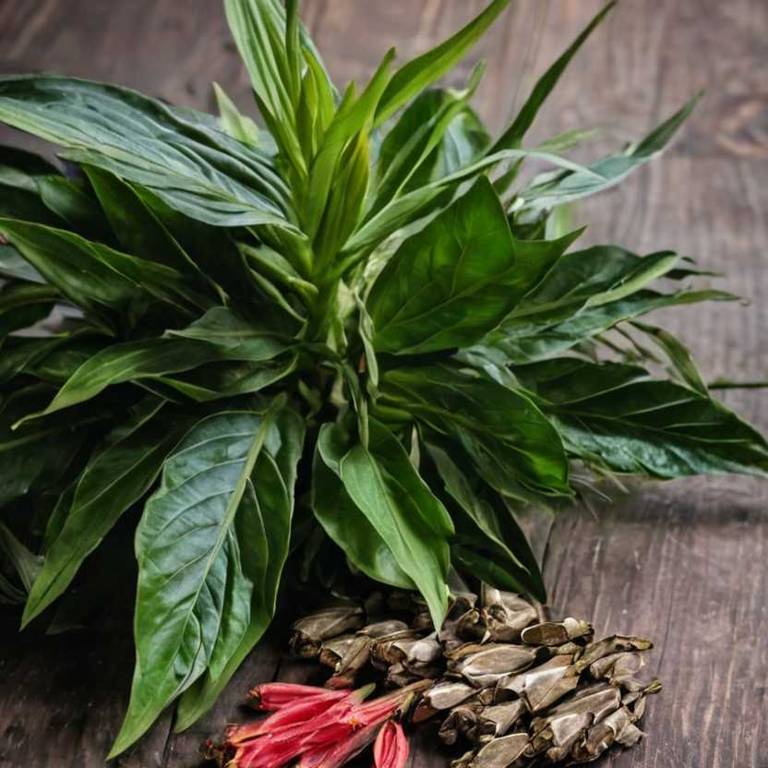10 Best Alpinia Officinarum Preparations

The best medicinal preparations of Alpinia officinarum are teas, decoctions, tinctures, capsules, and creams, each offering unique benefits for health and wellness.
Teas made from its dried rhizomes are commonly used to aid digestion and reduce stress.
Decoctions involve boiling the herb to extract its active compounds, enhancing its therapeutic effects.
Tinctures provide a concentrated form, suitable for targeted herbal remedies.
Capsules offer a convenient way to consume the herb, while creams are applied topically to soothe skin conditions.
Below there's a list of the 10 best herbal preparations of alpinia officinarum for medicinal purposes.
1. Teas
Alpinia officinarum teas is commonly used to relieve digestive discomfort, reduce inflammation, and support respiratory health.
This herbal preparation is often employed to treat ailments such as indigestion, gastritis, coughs, and bronchitis. The bioactive constituents responsible for its medicinal properties include alkaloids, flavonoids, phenolic compounds, and essential oils. These compounds exhibit anti-inflammatory, antimicrobial, and antioxidant effects.
Alpinia officinarum teas is also believed to aid in stress relief and promote overall wellness.

2. Decoctions
Alpinia officinarum decoctions is commonly used to treat digestive issues, respiratory conditions, and inflammation due to its traditional medicinal properties.
This herbal preparation is often employed to alleviate symptoms of gastritis, peptic ulcers, and asthma. It is also used in Chinese medicine to improve circulation and reduce menstrual cramps. The bioactive constituents responsible for these effects include volatile oils, alkaloids, flavonoids, and phenolic compounds.
These components contribute to the plant's anti-inflammatory, antimicrobial, and antioxidant properties.

3. Tinctures
Alpinia officinarum tinctures is commonly used to treat digestive disorders, nausea, and gastrointestinal discomfort due to its soothing and carminative properties.
These tinctures are also utilized for their anti-inflammatory and analgesic effects, helping to alleviate symptoms of arthritis and muscle pain. Additionally, they are sometimes used to support respiratory health by easing coughs and reducing inflammation in the airways. The bioactive constituents responsible for these effects include essential oils such as cineole, gingerol, and zingiberene, as well as various flavonoids and alkaloids.
These compounds work synergistically to provide the plant's medicinal benefits.

4. Capsules
Alpinia officinarum capsules is commonly used to treat digestive disorders, nausea, and inflammatory conditions.
This herbal preparation is widely utilized for its ability to alleviate symptoms of indigestion, gastritis, and vomiting. It is also used in traditional medicine to reduce inflammation and support respiratory health. The bioactive constituents responsible for its medicinal properties include volatile oils, alkaloids, flavonoids, and phenolic compounds.
These compounds contribute to its anti-inflammatory, antimicrobial, and gastroprotective effects.

5. Creams
Alpinia officinarum creams is commonly used to alleviate pain and inflammation associated with various musculoskeletal conditions.
These creams are often applied topically to treat ailments such as arthritis, muscle strains, and joint pain. The bioactive constituents responsible for their medicinal properties include essential oils, alkaloids, and phenolic compounds. These compounds possess anti-inflammatory, analgesic, and antioxidant effects.
Alpinia officinarum creams are also believed to promote circulation and reduce swelling in affected areas.

6. Syrups
Alpinia officinarum syrups is commonly used to treat digestive issues, respiratory conditions, and inflammation.
This herbal preparation is often employed to alleviate symptoms of gastritis, peptic ulcers, coughs, and bronchitis. It is also used to reduce nausea and promote digestion. The bioactive constituents responsible for its medicinal properties include volatile oils, flavonoids, alkaloids, and phenolic compounds.
These compounds contribute to its anti-inflammatory, antimicrobial, and carminative effects.

7. Lozenges
Alpinia officinarum lozenges is commonly used to relieve symptoms of respiratory tract infections, sore throat, and cough.
These lozenges are often employed in traditional medicine to address inflammation and irritation of the throat, as well as to support respiratory health. The most common medicinal uses include treating sore throats, coughs, and inflammatory conditions of the upper respiratory tract. The bioactive constituents responsible for these effects include essential oils, flavonoids, alkaloids, and phenolic compounds, which possess anti-inflammatory, antimicrobial, and analgesic properties.
These components work synergistically to reduce inflammation, combat pathogens, and soothe mucous membranes.

8. Oinments
Alpinia officinarum oinments is commonly used to relieve pain, reduce inflammation, and treat skin conditions.
These ointments are frequently applied topically to address ailments such as arthritis, muscle pain, and dermatitis. The medicinal properties of Alpinia officinarum oinments are attributed to bioactive constituents like essential oils, alkaloids, and flavonoids. These compounds possess anti-inflammatory, analgesic, and antimicrobial effects.
Additionally, the ointments may support wound healing and enhance circulation in the affected areas.

9. Oils
Alpinia officinarum oils is commonly used to treat digestive issues, respiratory conditions, and skin disorders due to its therapeutic properties.
The most common medicinal uses include alleviating symptoms of indigestion, nausea, and gastrointestinal discomfort, as well as reducing inflammation and coughing in respiratory ailments. It is also applied topically to address skin infections and promote wound healing. The bioactive constituents responsible for these effects include essential oils such as cineole, terpinene, and sesquiterpenes, which possess antimicrobial, anti-inflammatory, and antioxidant properties.
These compounds work synergistically to provide the plant's wide range of health benefits.
